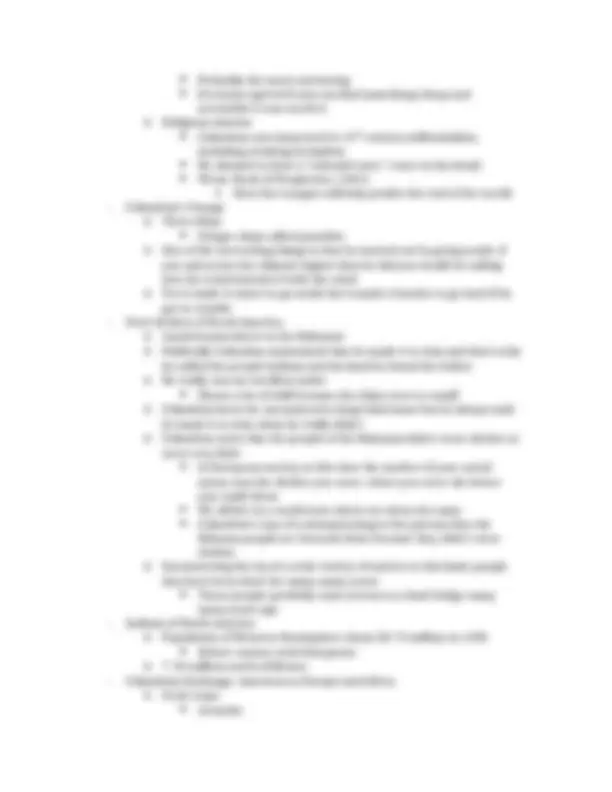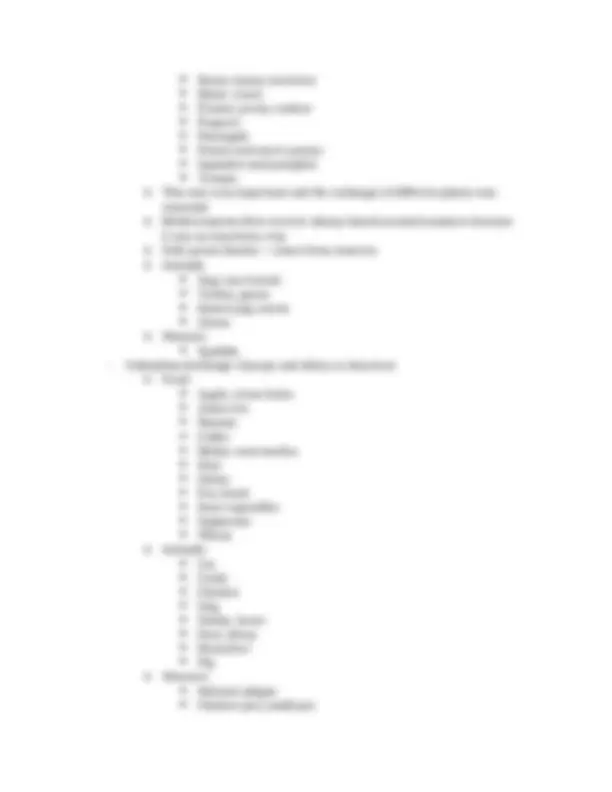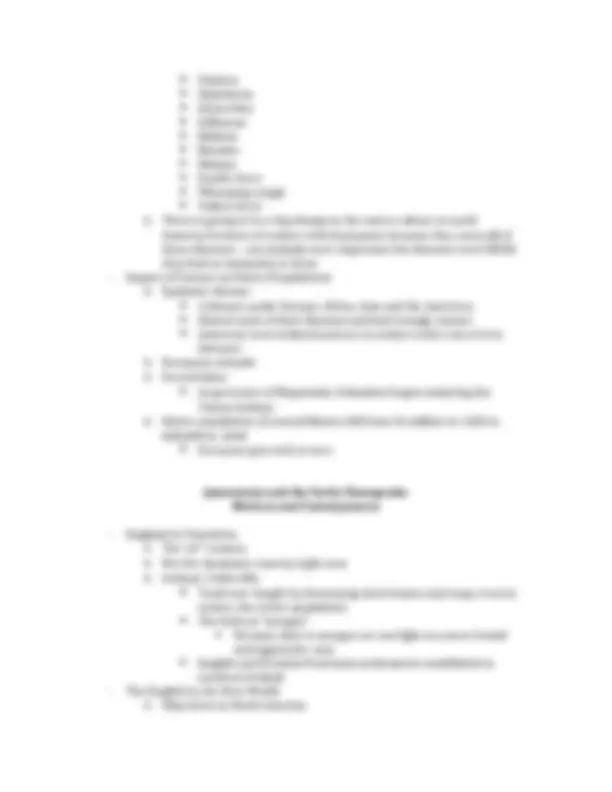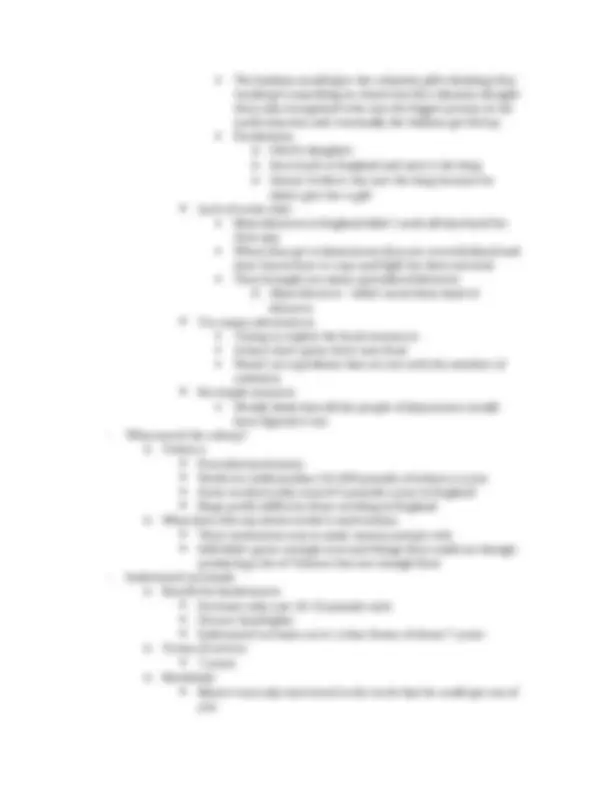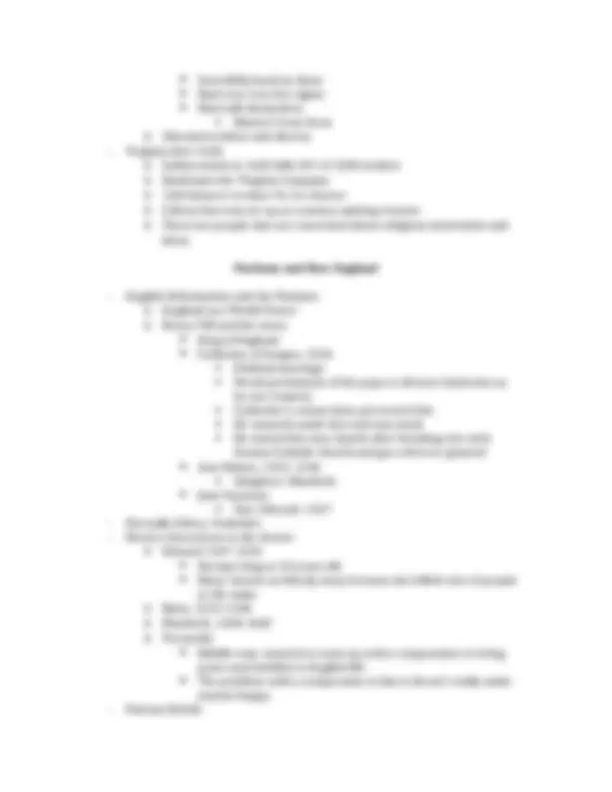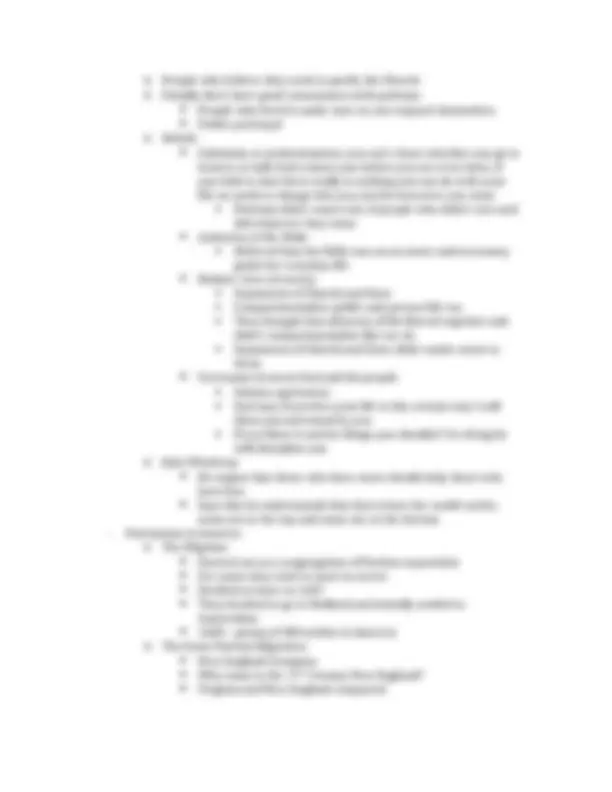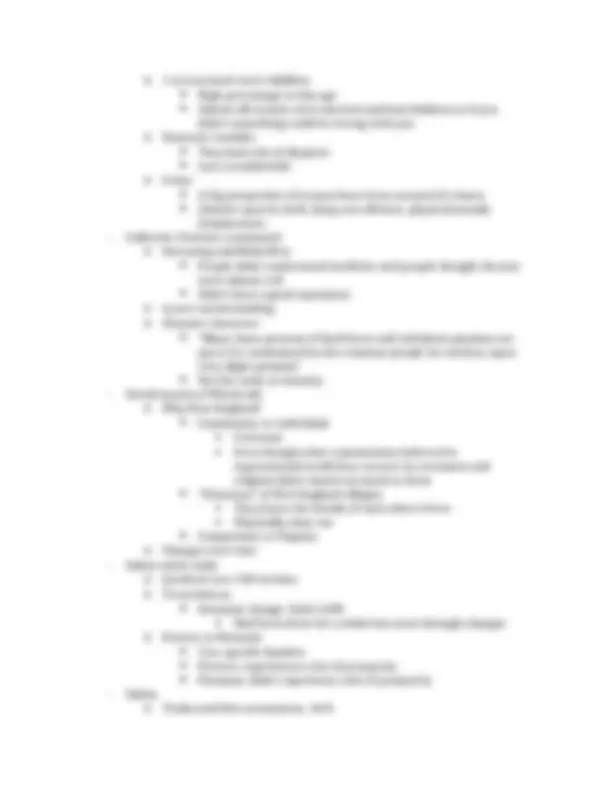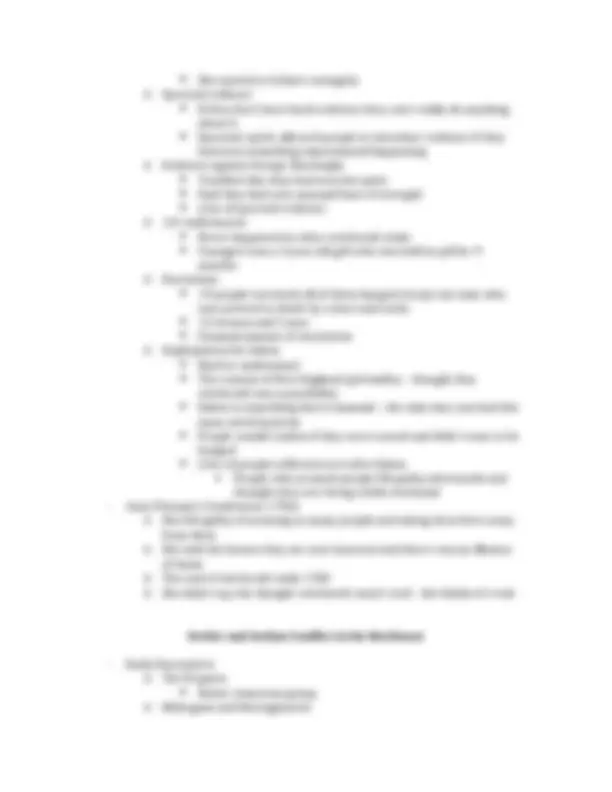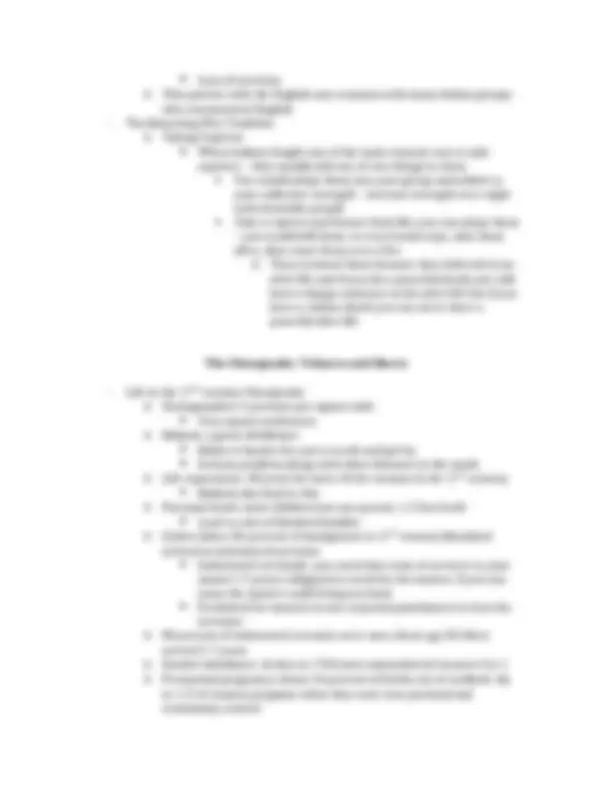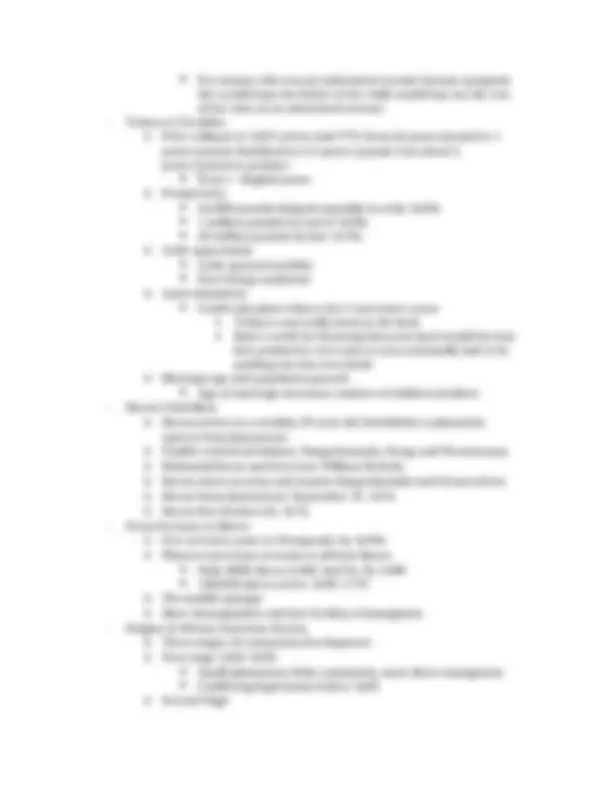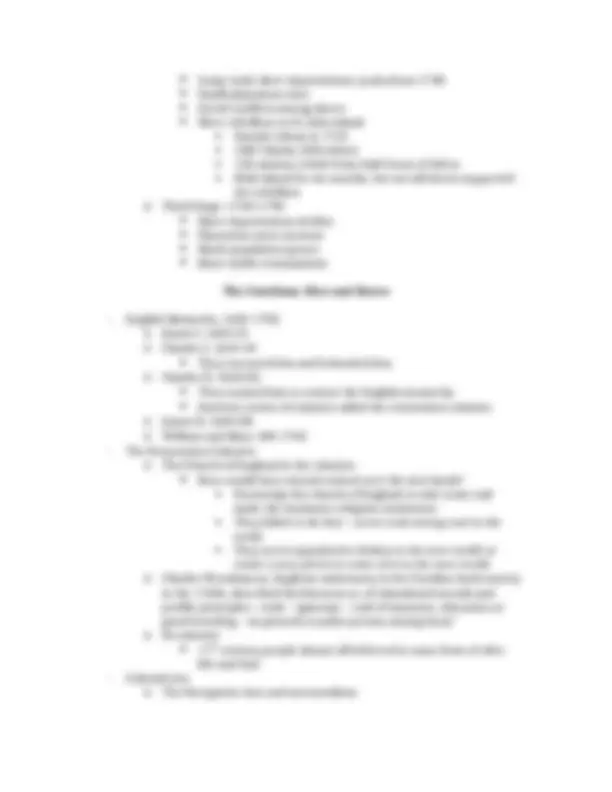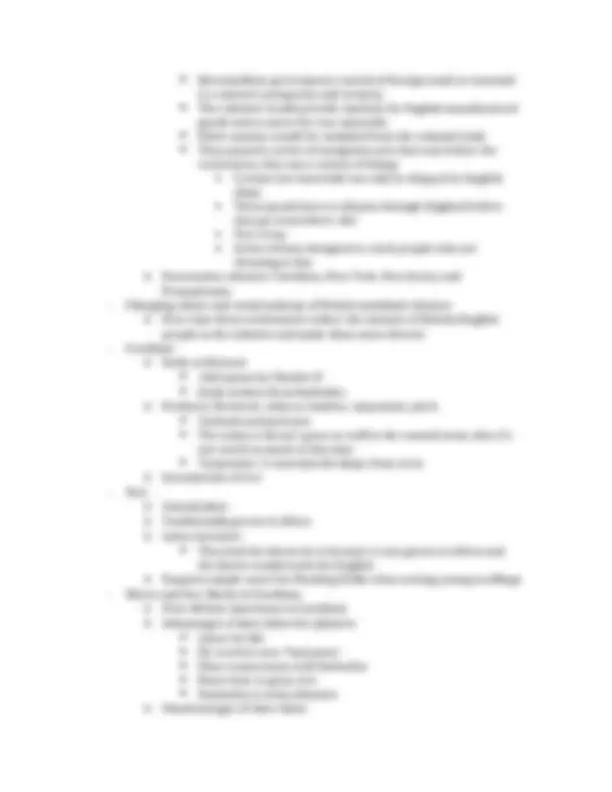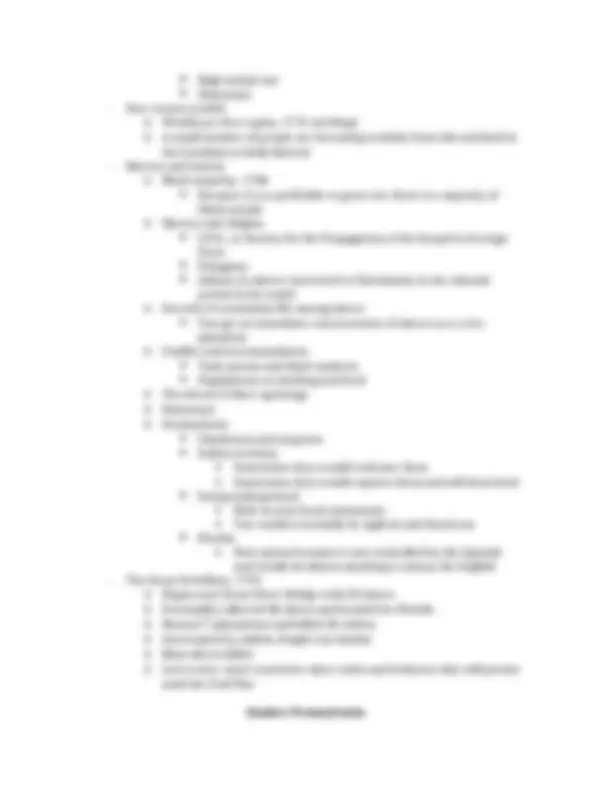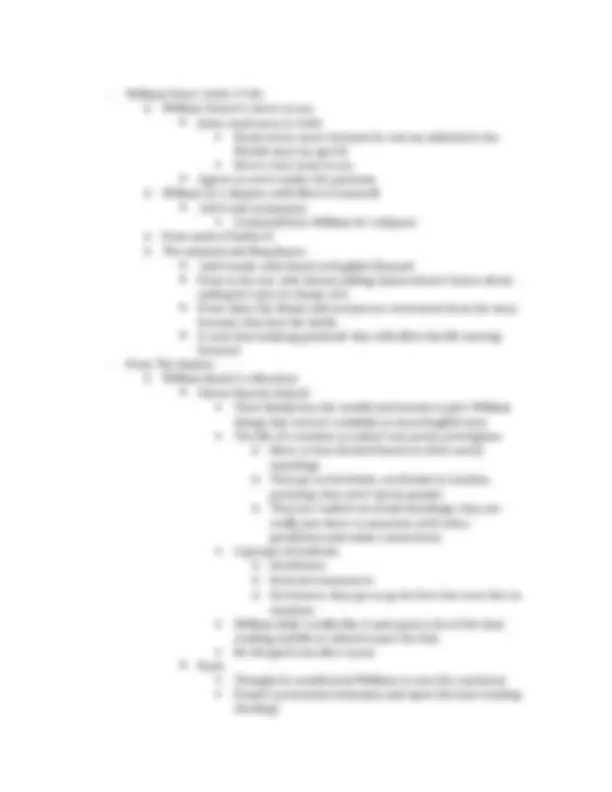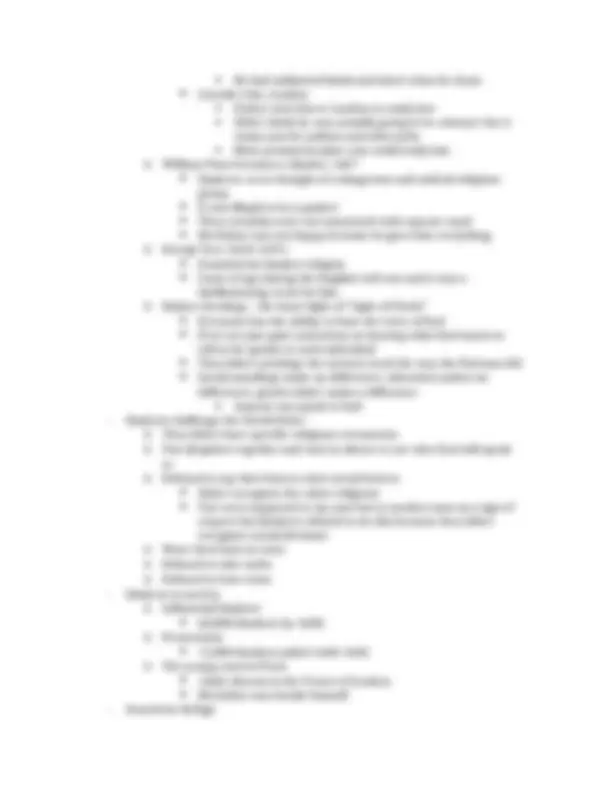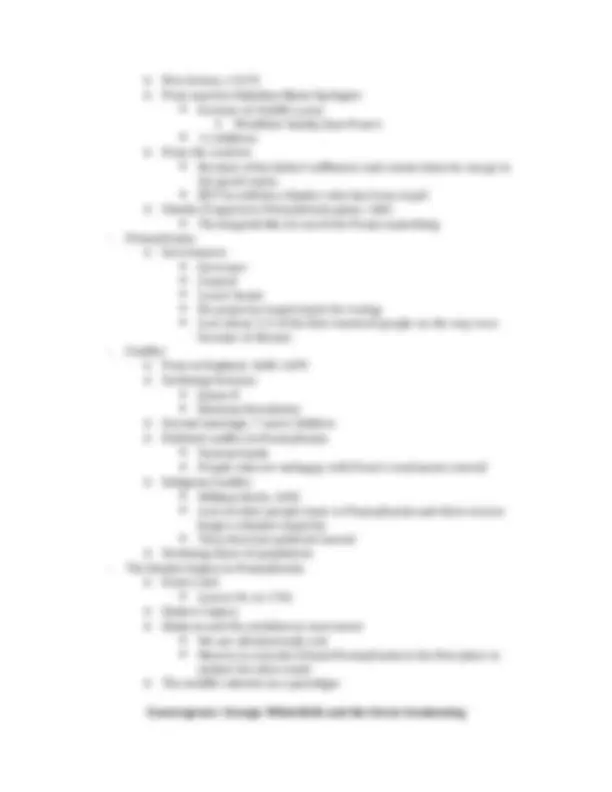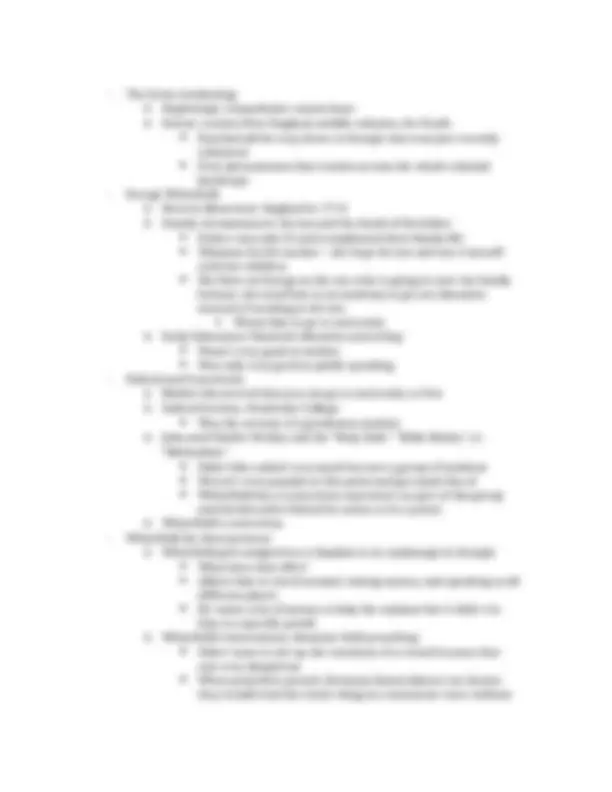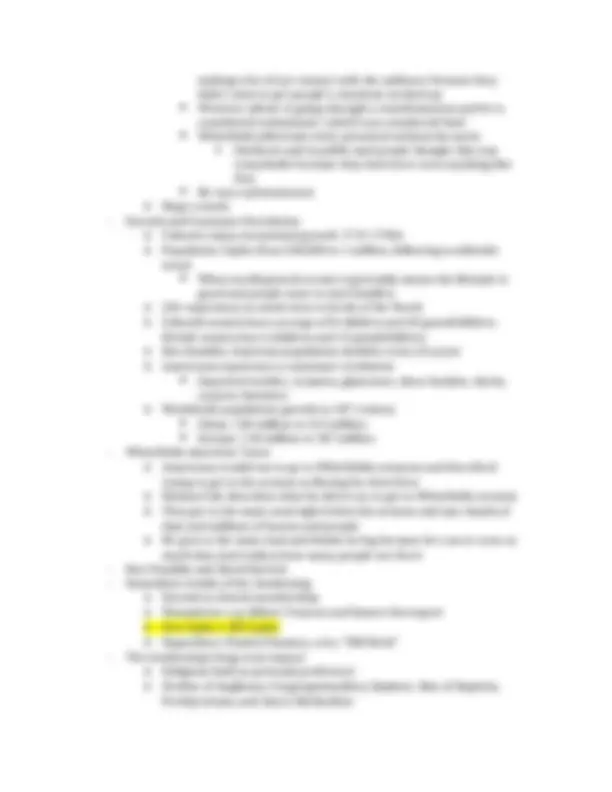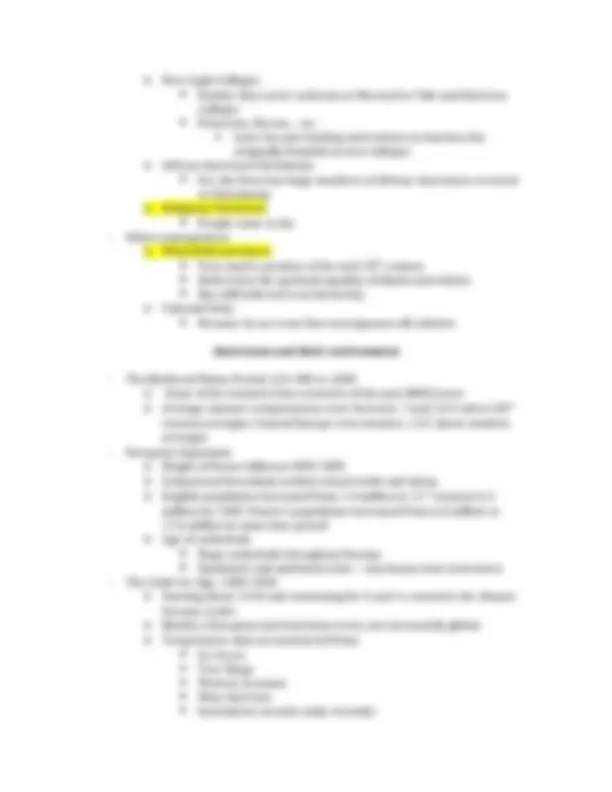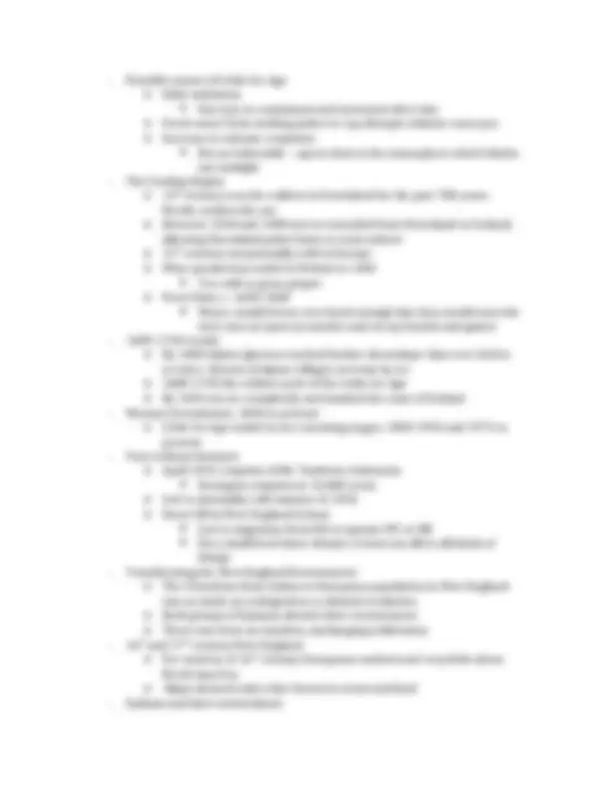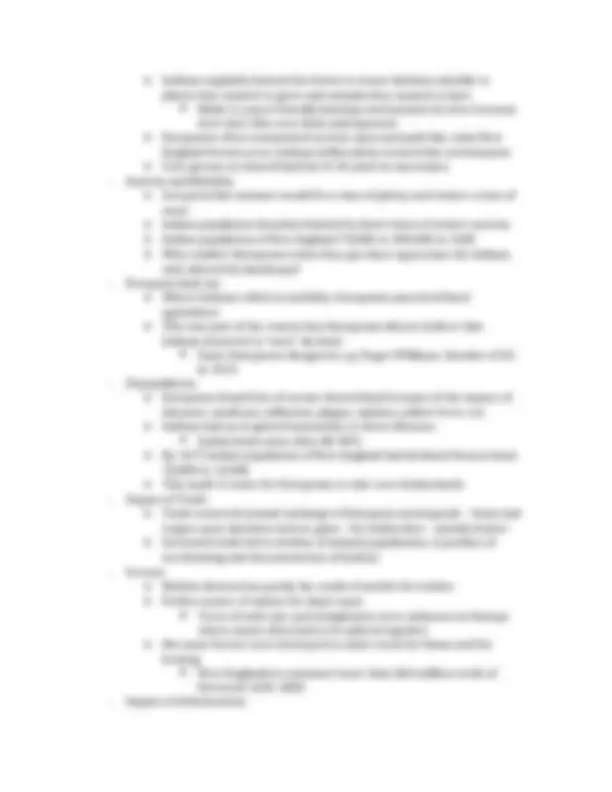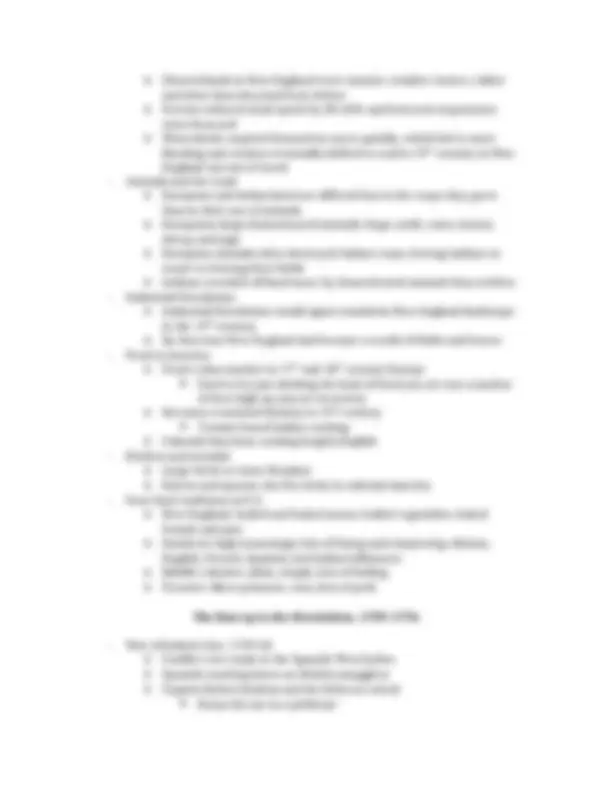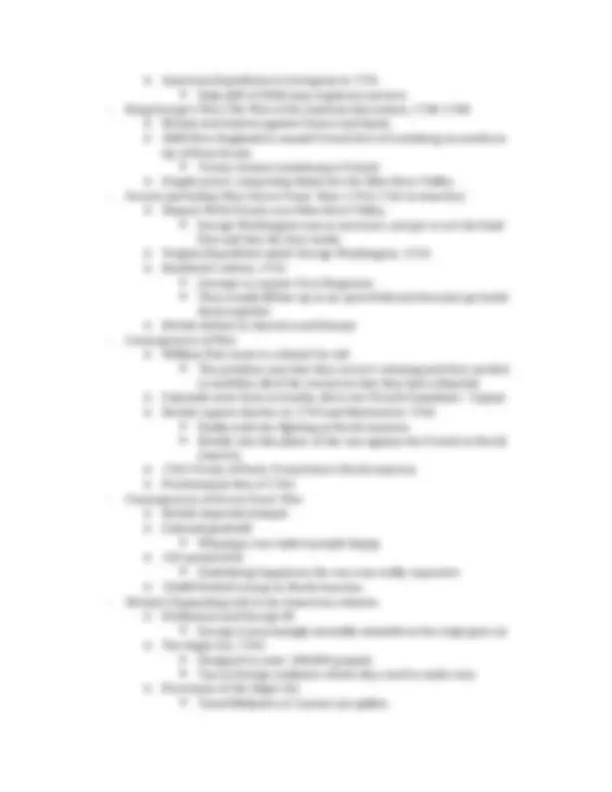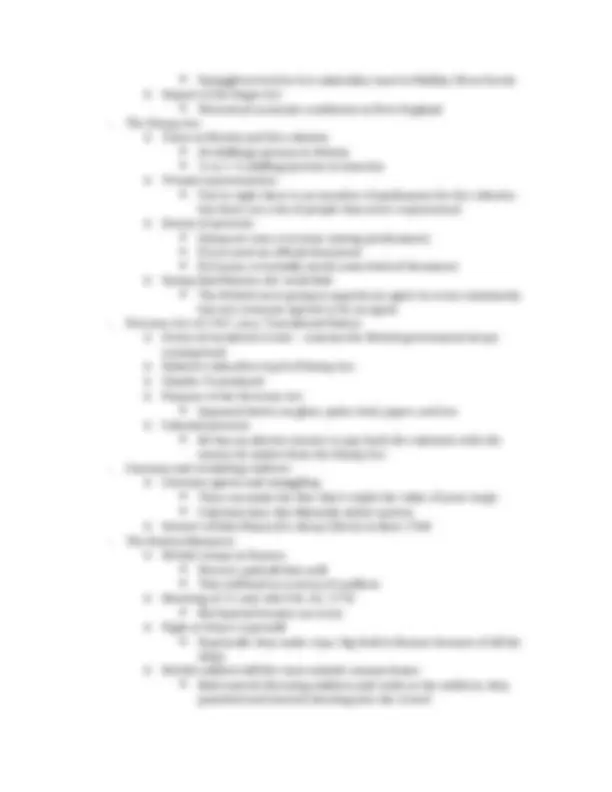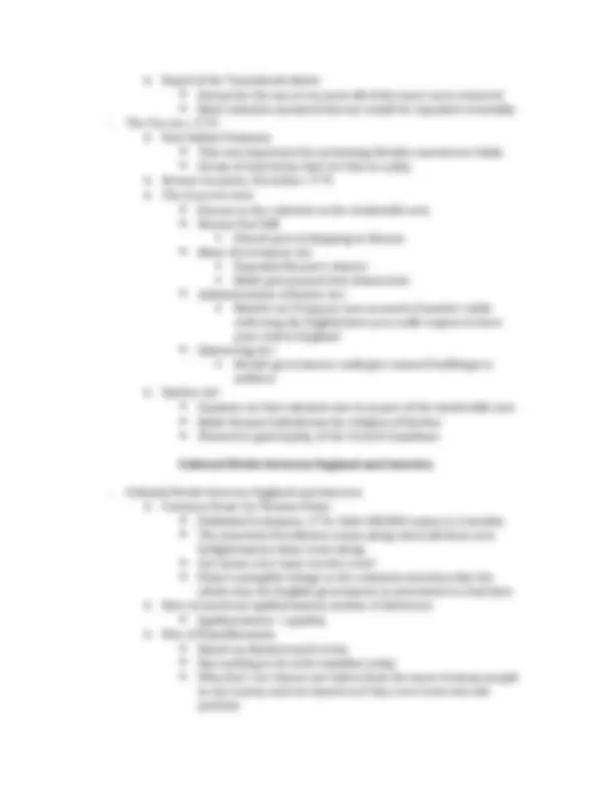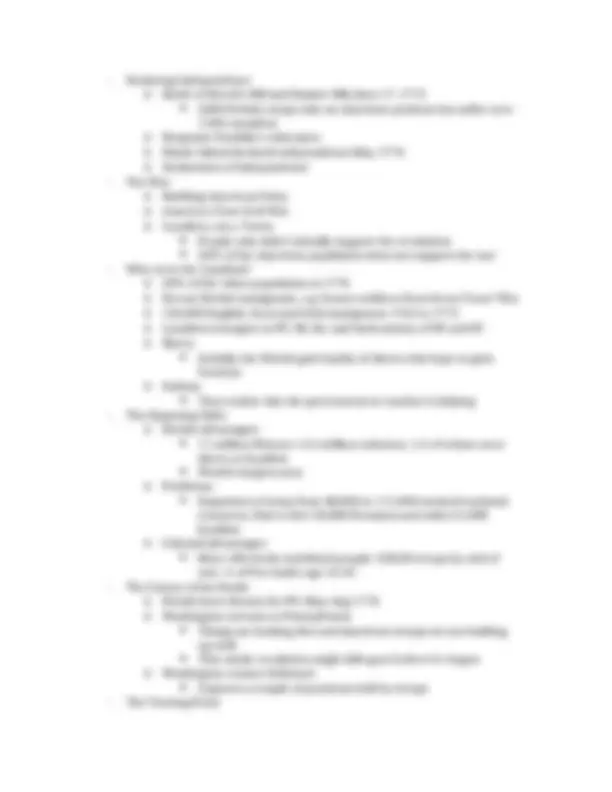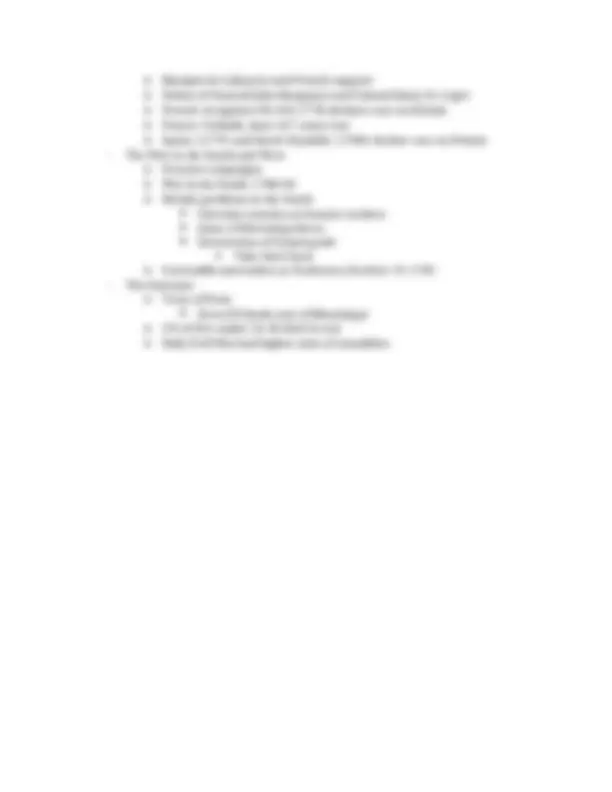Download Early New England: Puritanism, Witchcraft, and the Great Awakening - Prof. John Wigger and more Study notes World History in PDF only on Docsity!
History 1000 August 25, 2011 First Contacts: Motives and Consequences
- Columbus as a case study o Born 1450 in Genoa, Italy or in Spain To a middle class family, not wealthy; father was a weaver and made his living with his hands (not an aristocrat) o Ambitious to become part of the nobility How to become rich and famous We see society divided into three parts but Europe was either aristocrats or commoners Gentleman who is part of the aristocracy is defined as someone who doesn’t have to work to live Wealth is also tied into land ownership o How did you get wealthy if you were a commoner? You could become a priest Join the army Marry into wealth o Columbus chose a fourth option to explore at sea o Early life at sea Sails over a lot of territory before the famous voyage to north America
- European expansion o The black death (plague) and Hundred Years War (1337-1453) devastated much of Europe Devastated much of the population of Europe o Population growth and commodity prices rebounded after 1450 Trying open up new markets and new trade routes; especially to the wealth of Asia The goods you can get from India and China are extremely valuable but hard to get If you can get them by sea you can make a lot of money o This growth continued into the 16th^ century
- Early Exploration o Canary islands colonized by Spain 1402 o Azores colonized by Portugal 1439 o Cape Verde islands colonized in Columbus’s lifetime
- 15 th^ century trade and exploration o Age of discovery o Overland trade routes are pretty long so Portugal went around land via sea and they can then bring things back more quickly o They are trying to find a way to trade with Asia
- Motivations for Journeys to the New World
o Adventurers People willing to take risks and make quick money Conquistadors; Jamestown, Virginia (mostly o Colonists or Localists Plymouth pilgrims; Massachusetts Puritans People who were looking for a new place to live – here for the long haul o Missionaries Franciscans in the Southwest; Jesuits in Canada They come with a mission: something they want to communicate to the new world Its often their religion
- Columbus’s Theory o His big idea to set him apart was not FLAT EARTH o It’s a myth Greeks accurately measured earth’s circumference in 3rd century B.C. Charlemagne, Holy Roman Emperor, 742- o Holding a sword and an orb; he is the conqueror of the world o Columbus underestimated the world’s circumference by a third (16,000 miles v. 26,000) The later is the right number; Columbus was wrong He argued that the world was a lot smaller than a lot of experts thought it was He thought it would be feasible to go to Europe to China and not stop for food
- Inventing the flat earth o The myth of a flat earth was invented in the 19th^ century Fit with belief in progress, and the triumph of science over religion The founding of America represented progress and enlightenment o The myth was created long after Columbus’s lifetime o But Columbus never sailed around the world!
- Justifications for Columbus’s voyage o You need support from someone for money and protection (specifically if you’re successful) o Quest for new islands Europeans had tried to settle new islands (canary and cape verde) but none of those island groups had been very profitable o Search for a new continent The “Antipodes” opposite Europe What are you going to do with a new continent if you find it? o Passage to Asia
Beans (many varieties) Maize (corn) Peanut, pecan, cashew Peppers Pineapple Potato and sweet potato Squashes and pumpkin Tomato o This was very important and the exchange of different plants was essential o Mediterranean diets weren’t always based around tomatoes because it was an American crop o Irish potato famine – comes from America o Animals Dog (one breed) Turkey, goose Guinea pig, nutria Llama o Diseases Syphilis
- Columbian Exchange: Europe and Africa to Americas o Food: Apple, citrus fruits Asian rice Banana Coffee Melon, watermelon Oats Onion Pea, lentil Root vegetables Sugarcane Wheat o Animals: Cat Cattle Chicken Dog Donky, horse Goat, sheep Honeybee Pig o Diseases: Bubonic plague Chicken pox, small pox
Cholera Diphtheria Gonorrhea Influenza Malaria Measles Mumps Scarlet fever Whooping cough Yellow fever o There is going to be a big change in the native culture in north America because of contact with Europeans because they carry all of these diseases – yes animals were important but diseases were HUGE they had no immunity to them
- Impact of Contact on Native Populations o Epidemic disease 4 disease pools: Europe, Africa, Asia and the Americas Shared most of their diseases and had enough contact Americas were isolated and are in contact with a ton of new diseases o European animals o Forced labor As governor of Hispaniola, Columbus began enslaving the Tainos Indians o Native population of central Mexico fell from 25 million in 1520 to 850,000 in 1608 Everyone gets sick at once Jamestown and the Early Chesapeake Motives and Consequences
- England in Transition o The 16th^ century o Not the dominant country right now o Ireland, 1560s-80s Total war: fought by destroying their homes and crops even in winter; the entire population The Irish as “savages” Because they’re savages we can fight in a more brutal and aggressive way English and Scottish Protestant settlements established in northern Ireland
- The English in the New World o Objectives in North America
One of the original colonists Establishes a military discipline Makes the surviving settlers get together and organizes them into work groups Pocahontas saved his life Not sure that really happened Maybe she did intervene o Powhatan and Pocahontas Her father o Smith leaves in 1609 He was injured by a gunpowder incident The colony reverts to their old ways o Another breakdown, 1609- o “So lamentable was our scarcity, that we were constrained to eat dogs, cats, rats, snakes, toadstools, horsehides, and what not; one man out of the misery endured, killing his wife powdered her up with flower to eat her, for which he was burned.” Survivor of the winter o 400 of 500 settlers died between September 1609 and May 1610 o Sir Thomas Dale Brings new recruits in 1611 Attempts to establish some type of discipline but fails A lot of the colonists spent a lot of their time bowling in the streets o More hard times o Population only 700 in 1619 o 3570 new settlers 1619- Mostly from England o Population 700 in 1622 All the other people died Enormously high death rate
- Why so much trouble at Jamestown? o Possibly explanations: Too many gentlemen (someone who did not have to work for a living, only worked for the broader good) Hunger and disease (but they could bowl!) Spent time bowling but didn’t plant any crops Communal Organization Dependence on Indians Thought they could get what they needed from local Indians Thought of themselves as superior to Indians Land ownership = powerful and wealthy o There wasn’t someone who had a whole lot than anyone else, they couldn’t see who the rulers were
The Indians would give the colonists gifts thinking they would get something in return but the colonists thought they only recognized who was the bigger person in the north America and eventually the Indians got fed up Pocahontas o Chief’s daughter o Goes back to England and meet’s the king o Doesn’t believe she met the king because he didn’t give her a gift Lack of work ethic Most laborers in England didn’t work all that hard for their pay When they get to Jamestown they are overwhelmed and don’t know how to cope and fight for their survival They brought too many specialized laborers o Glass blowers – didn’t need these kind of laborers Too many adventurers Trying to exploit the local resources Army’s don’t grow their own food Wasn’t an expedition that set out with the mindset of colonists No simple answers Would think that all the people of Jamestown would have figured it out
- What saved the colony? o Tobacco Provided motivation Workers could produce 25-200 pounds of tobacco a year Farm workers only earned 3 pounds a year in England Huge profit/different from working in England o What does this say about settler’s motivations Their motivation was to make money and get rich Still didn’t grow enough corn and things they could eat though producing a lot of Tobacco but not enough food
- Indentured servitude o Benefit for landowners Servants only cost 10-12 pounds each 50 acre headrights Indentured servants serve a time frame of about 7 years o Terms of service 7 years o Hardships Master was only interested in the work that he could get out of you
o People who believe they need to purify the Church o Usually don’t have good connotation with puritans People who lived to make sure no one enjoyed themselves Unfair portrayal o Beliefs Calvinism or predestination: you can’t chose whether you go to heaven or hell; God creates you before you are even born; if you believe that there really is nothing you can do with your life on earth to change this you can live however you want Puritans didn’t want a lot of people who didn’t care and did whatever they want Authority of the Bible Believed that the Bible was an accurate and necessary guide for everyday life Holistic view of society Separation of Church and State Compartmentalize public and private life too They thought that all areas of life flowed together and didn’t compartmentalize like we do Separation of Church and State didn’t make sense to them Covenants between God and his people Solemn agreement God says if you live your life is this certain way I will bless you and stand by you If you blow it and do things you shouldn’t be doing he will discipline you o John Winthrop He argues that those who have more should help those who have less Says that he understands that that is how the world works, some are at the top and some are at the bottom
- Puritanism in America o The Pilgrims Started out as a congregation of Puritan separatists For years they tried to meet in secret Decided to leave in 1607 They decided to go to Holland and initially settled in Amsterdam 1620 – group of 300 settles in America o The Great Puritan Migration New England Company Who came to the 17th^ century New England? Virginia and New England compared
The most prominent person in all their towns was the minister; more close knit than in the colonial south o The First Generation Works out pretty well as a whole o Church and State Very holistic view but keenly aware than England had persecuted them and the bishops weren’t any help at all They want their churches to be important but they don’t want a distinct link between Church and State Still want their government to be a godly government in their eyes They came up with a new idea Lets only allow men who are church members vote in elections They will be more likely to elect godly rulers Let’s make it a hard thing to become a church member – those who have had a conversion experience and share it with the Church You became a member by being born – baptized Had to own a certain amount of property to vote o The Puritan Sermon Important Most people heard at least 2 – 2 hour sermons a week It was the event in the community in which people heard things that were important
- The New England Way Under Stress o Halfway Covenant, 1662 More people weren’t following the religion that their parents were You could become a halfway member You don’t have to have a conversion experience you just have to commit Shows you that just a generation after the original founding a really strident system was beginning to breakdown o Dominion of New England, 1685 James II came to throne Was overthrown eventually – doesn’t like Puritans and makes all of New England a Royal colony Ends all religions connects with religion and government Only reigns for 3 years – overthrown in the Glorious revolution They undid the Dominion but didn’t give the Puritans back the original charter o Glorious Revolution Take away a lot of religion by not giving them back their original charter
o 1 in 6 accused were childless High percentage in this age Almost all women were married and had children so if you didn’t something could be wrong with you o Domestic troubles They had a lot of disputes Led a troubled life o Crime A big proportion of women have been accused of crimes Abusive speech, theft, lying, sex offenses, physical assault, drunkenness
- Collective Portrait (continued) o Doctoring and Midwifery People didn’t understand medicine and people thought doctors were almost evil Didn’t have a good reputation o Lower social standing o Abrasive character “Many times persons of hard favor and turbulent passions are apt to be condemned by the common people for witches, upon very slight grounds” Not the same as insanity
- Social matrix of Witchcraft o Why New England? Community vs. individual Covenant Even though other communities believed in supernatural world they weren’t in covenants and religion didn’t matter as much to them “Closeness” of New England villages They knew the details of each other’s lives Physically close too Comparison to Virginia o Changes over time
- Salem witch trials o Involved over 100 witches o Town history Dramatic change 1660- Had been there for a while but went through changes o Porters vs Putnams Two specific families Porters: experiences a lot of prosperity Putnams: didn’t experience a lot of prosperity
- Salem o Tituba and first accusations, 1691
She started to behave strangely o Spectral evidence If they don’t have hard evidence they can’t really do anything about it Spectral: spirit; allowed people to introduce evidence if they had seen something supernatural happening o Evidence against George Burroughs Testified that they had seen his spirit Said they had seen unusual feats of strength A lot of spectral evidence o 141 indictments Never happened in other witchcraft trials Youngest was a 4 year old girl who was held in jail for 9 months o Executions 19 people executed; all of them hanged except one man who was pressed to death by a door and rocks 14 women and 5 men Unusual amount of executions o Explanations for Salem Hard to understand The context of New England spirituality – thought that witchcraft was a possibility Salem is something that is unusual – the only time you had this mass witch hysteria People would confess if they were scared and didn’t want to be hanged A lot of people reflected on it after Salem People who accused people felt guilty afterwards and thought they wre being a little irrational
- Anne Putnam’s Confession (1706) o She felt guilty of accusing so many people and taking their lives away from them o She said she knows they are now innocent and that it was an illusion of Satan o The end of witchcraft trials 1700 o She didn’t say she thought witchcraft wasn’t real – she thinks it’s real Settler and Indian Conflict in the Northeast
- Early Encounters o The Pequots Native American group o Mohegans and Narragansetts
o Questioned taking Indian Land The only way this was ok was if you paid the Indians what they thought was a good price
- Separation of Church and State o Williams concluded that separation from Church of England was necessary o A national church was a political church o Exiled from Massachusetts Bay Colony in October 1635 o Escapes south of Bay Colony o Aided by Narragansett Indians Put him up for the winter and helped him find a town
- Rhode Island o Williams founded Providence, R.I. o Joined by Anne Hutchinson in 1638 o Returns to England to obtain and protect R.I. charter o Governor 1654-
- Religious Freedom o Williams: “God requireth not an uniformity of Religion” o All should enjoy “soul liberty” You should be free within your own soul and make up your own mind o R.I. welcomed Quakers and Jews Problem with welcoming anyone was that eventually everyone would all come o Quakers soon dominated the colony, elected Quaker governor in 1672
- Rhode Island marginalized o Almost no one in colonial New England followed Williams’ model o Rhode Island ridiculed as the “licentious republic” or the “sink hold of New England” The dumping ground where all kinds of crazy people ended up
- Weapons and Tactics o Guns were important in conflict between settlers and native Americans o Matchlock Time of Pequot war and through Metacom’s war The standard gun used in war in Europe Colonists were most familiar with it but not familiar with guns in general Supposed to close your eyes because when shot it emitted a lot of smoke and powder You put the ball and the gun powder down the barrel and you have to burn a wick and keep it burning when you’re in the field Difficult to use
o Flintlock Smaller and lighter Also a musket Instead of relying on a burning wick a piece of mineral (flint) would strike a metal strip and cause a spark that would light the powder
- Proficiency with Firearms: A Cultural Comparison o The English and hunting Hunting was illegal in England because it was most estates owned by people When they wanted to hunt they hunted with their dogs Was considered a sport – not a means to get food o Indians and hunting Spent a lot of time Hunting and fighting were two things that young Indian men were supposed to do Couldn’t become a respectable male in Indian society without doing these Insisted on flintlocks and knew they were better weapons Proficient with using them
- The Wampanoags and Metacom o Metacom or King Philip o 52 of New England’s 90 towns destroyed 1675- o Indians were very successful early on They were used to using guns in the field and English wasn’t as good at it at first It wasn’t something the English practiced o Pequots and Mahicans o Mohawks Fairly big and powerful group Allied with the English and gave them help They had more resources and a much larger population o 800 colonists and 3000 Indians were killed o Settlement pushed back a generation o Different ways of fighting – emphasize
- The Iroquois o Mohawks, Oneidas, Onondagas, Cayugas, Senecas o Influence as far south as Virginia and west into Ohio o Beaver Wars of the 17th^ century Allied with the Dutch against the French and Algonquians o 4 stages of Iroquois History with Europeans: Massive depopulation Small pox Economic dependence on trade Entanglement in imperial struggles
If a woman who was an indentured servant became pregnant she would hope the father of her child would buy out the rest of her time as an indentured servant
- Tobacco’s Troubles o Price collapse in 1629: prices sink 97% from 36 pence/pound to 1 pence/pound. Stabilized at 2-3 pence/pound. Cost about 2 pence/pound to produce Pence = English pence o Productivity 65,000 pounds shipped annually in early 1620s 1 million pounds by end of 1630s 20 million pounds by late 1670s o Little opportunity Little upward mobility Poor living conditions o Land exhaustion Could only plant tobacco for 3 successive years Tobacco was really hard on the land Had to settle for knowing that your land would become less productive over time or you continually had to be pushing out into new lands o Marriage age and population growth Age of marriage increases; number of children declines
- Bacon’s Rebellion o Bacon arrives as a wealthy 29 year old. Establishes a plantation upriver from Jamestown o Conflict with local Indians; Susquehannahs, Doegs and Piscattaways o Nathanial Bacon and Governor William Berkely o Bacon raises an army and attacks Susquehannahs and Ocaneechees o Bacon burns Jamestown; September 19, 1676 o Bacon dies October 26, 1676
- From Servants to Slaves o Few servants came to Chesapeake by 1690s o Planters turn from servants to African Slaves Only 4000 slaves in Md. And Va. By 1680 100,000 slaves arrive 1690- o The middle passage o Slave demographics and low fertility of immigrants
- Origins of African American Society o Three stages of community development o First stage 1650- Small plantations, little community, most slaves immigrants Conflicting legal status before 1660 o Second Stage
Large scale slave importations; peak about 1740 Small plantation sizes Social conflicts among slaves Slave rebellion on St. John island Danish colony in 1733 1087 blacks; 208 whites 150 Aminas rebels from Gold Coast of Africa Held island for six months, but not all slaves supported the rebellion o Third Stage: 1740- Slave importations decline Plantation sizes increase Black population grows More stable communities The Carolinas: Rice and Slaves
- English Monarchs, 1603- o James I; 1603- o Charles I; 1625- They executed him and beheaded him o Charles II; 1660- They wanted him to restore the English monarchy Started a series of colonies called the restoration colonies o James II; 1685- o William and Mary 188-
- The Restoration Colonies o The Church of England in the colonies How would they extend control over the new lands? Encourage the church of England to take route and make the dominate religious institution They failed to do that – never took strong root in the south They never appointed a bishop to the new world or entice a new priest to come over to the new world o Charles Woodmason, Anglican missionary in the Carolina backcountry in the 1760s, described his listeners as :of abandoned morals and profile principles – rude – ignorant – void of manners, education or good breeding, - no genteel or polite person among them” o No atheists 17 th^ century people almost all believed in some form of after life and God
- Colonial ties o The Navigation Acts and mercantilism

